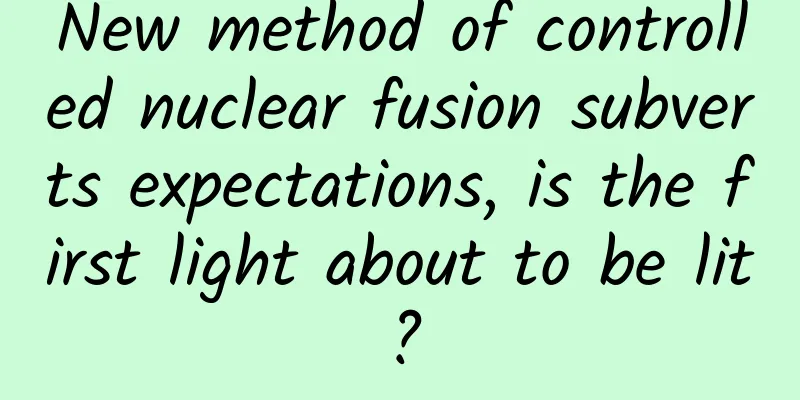New method of controlled nuclear fusion subverts expectations, is the first light about to be lit?

|
Yesterday I saw a piece of news that overturned my expectations for the future of controlled nuclear fusion. A little-known startup company, Zap Engineering, is using a completely new method to save money and achieve a major breakthrough. Some industry experts and media have given high praise to this technology, believing it to be an important milestone in controlled nuclear fusion technology. Now, Zap Engineering is working to modularize this technology and claims that it will be launched on the market in the near future. Will this breakthrough really greatly shorten the commercialization process of controlled nuclear fusion? Let's find out. Let me briefly talk about what controlled nuclear fusion is. Controlled nuclear fusion is to use the principle of nuclear fusion inside the sun to create hydrogen nuclear fusion energy that can be released for a long time on the earth and used to benefit society. In fact, the explosion of a hydrogen bomb is the energy of nuclear fusion, but it is uncontrollable and disappears with a "boom". It can't benefit society except for war. Controlled nuclear fusion is to make the huge energy released instantly by the "boom" be released slowly, so that it can generate electricity and obtain inexhaustible energy for a long time. Because this energy is generated in a similar way to the sun, it is commonly known as the artificial sun or artificial small sun. But the core of the sun can continuously produce hydrogen nuclear fusion because of the huge mass of the sun, which leads to huge centripetal contraction pressure, which reaches 300 billion atmospheres. This kind of pressure cannot be artificially created on Earth, and it requires a temperature higher than the 15 million degrees of the core of the sun, which needs to be more than 100 million degrees. So the question is, how to heat the plasma to 100 million degrees? Moreover, the most heat-resistant metal on earth melts at only a few thousand degrees. What kind of container can be used to "contain" tens of thousands of plasmas at several thousand degrees during nuclear fusion? And how to make this high-temperature plasma generate electricity? These are the major problems that need to be solved for controlled nuclear fusion. Scientists have been working on this for decades and now have finally figured it out. There are three ways to contain the high-temperature plasma of nuclear fusion, namely magnetic confinement, inertial confinement, and gravity confinement. These methods are all non-material confinement methods, which are to prevent the high-temperature plasma from hitting the inner wall of the container. Gravitational confinement is the method used by the sun. It cannot be done on Earth, so people can only think of ways to use magnetic confinement and inertial confinement. As early as the 1950s, scientists in the former Soviet Union invented a device called Tokamak, which uses coils to generate a magnetic trap inside and confine high-temperature plasma in the magnetic trap. Current status of magnetic confinement controlled nuclear fusion development in the world/ The use of tokamak devices to develop controlled nuclear fusion technology is a classic magnetic confinement method and is in the mainstream position in the world. China has independently developed a non-circular cross-section full superconducting tokamak experimental device, referred to as EAST, which is currently in a leading position in the world. In the experiment, several world-leading achievements have been made, such as 70 million degree long pulse high parameter plasma maintained for 1056 seconds, plasma temperature 120 million degrees running time reached 101 seconds, and 1 megaampere plasma single flow was achieved. Many countries, such as the United States, Britain, and Japan, have also made progress in controlled nuclear fusion and can generate energy, but the duration is too short, and even if some is generated, the output energy is still insufficient. The main problem that needs to be solved next is to make the nuclear fusion plasma burn stably for a long time, and the output energy must be much higher than the input energy, which is symbolically expressed as reaching Q=1 or above. These problems are simple to say, but difficult to do. Therefore, experts from all over the world generally agree that it will take at least 30 years or even longer to truly realize the commercial application of controlled nuclear fusion. China has also made its own plans to achieve Q=5 in 2025 and gradually reach Q=10; to achieve demonstration project power generation in 2030, to achieve 200MW of power generation under Q=5 conditions, and initially reach 1GW of steady-state power generation under Q=10. Judging from this plan, if it can be successfully implemented, the first light can not be turned on during trial operation until 2030 at the earliest, and real commercial power generation will not be achieved until 2050. Development of inertial confinement controlled nuclear fusion/ The so-called inertial confinement is a method of using the inertia of particles to confine the particles themselves, thereby achieving a nuclear fusion reaction. The more classic method is to use a high-energy laser or a charged particle beam to irradiate a very small target pellet, causing the target surface material to melt rapidly and violently eject outward, and the reaction force of the ejection forms a shock wave that propagates inward, creating a huge pressure to fuse the hydrogen isotopes deuterium and tritium in the target pellet. This technology was proposed as early as the 1960s. The former Soviet Union and the United States have conducted a large number of experiments. my country has also started this experiment since 2000, but so far this technology has not made any major breakthroughs and is still in the laboratory test stage. In May this year, it was reported that a British company called First Light Fusion has taken a different approach and used high-speed ejection technology to trigger nuclear fusion. Specifically, two large super air acceleration guns are used to accelerate the fuel to 10 to 20 times the speed of sound and shoot it at small pieces embedded in the deuterium fuel core, forming a collapse shock wave. The instantaneous pressure reaches 1 billion atmospheres, causing the fuel to self-detonate at a high enough speed to achieve a nuclear fusion reaction. The high temperature of nuclear fusion will heat water to produce steam, which will drive the turbine to drive the generator to convert it into electrical energy, thus achieving controlled nuclear fusion power generation. The development of this device was inspired by marine pistol shrimps. Pistol shrimps, also known as drum shrimps, are about 5 cm long and live in shallow waters of tropical oceans. This shrimp has a "black technology" weapon. When attacking prey, it will instantly eject a stream of water at a speed of up to 100 kilometers per hour, forming a tiny low-pressure bubble. This bubble only takes one billionth of a second from generation to burst. When it explodes, the temperature instantly reaches 4,700 degrees. Prey hit by the bubble shock wave will hardly escape. Therefore, the high-speed "air gun" developed by First Light Fusio was named after the "pistol shrimp". It is said that this "pistol shrimp" nuclear fusion method is a big step forward from the ideal of power generation, and the cost is much lower than that of expensive high-energy laser emitters. The company currently plans to use this technology to open an experimental plant to produce electricity in 2030. This can definitely be called a dark horse, a unique effort in the development of inertial confinement controlled nuclear fusion, a true innovation and overtaking on the curve, and is currently highly regarded. Zap Engineering's controlled nuclear fusion technology is still magnetic confinement technology/ According to reports, the Seattle-based startup has developed a system called Z-pinch, which takes a completely different route from the Tokamak device. It abandons the large number of expensive magnets, magnetic coils, shielding materials, and the complex networks needed to protect them in the Tokamak device, and simply uses the magnetic field of the plasma itself to confine itself to a relatively short column. The report used a vivid metaphor: "pinning" the plasma into a column and "clamping" it. Plasma itself is charged, so in theory it can also form a magnetic field and a magnetic trap. The report only said that this technology is called "shear axial flow technology" and did not disclose more technical details. There is no need for us to delve into it, as these are matters for professionals. What we know now is that the technology has been successful and demonstrated at 500 kiloamperes. Zap Engineering's chief technology officer said the device, called FuZE-Q, is the fourth generation of the Z-pinch device, and the next generation will be designed to accommodate 650 kiloamperes of current to achieve the break-even point, or Q=1. The Zap Energy team has received $160 million in Series C funding and has ambitiously announced that the next step will be to bring this nuclear fusion technology to market as soon as possible. They envision achieving this goal by mass-producing reactors that will be modular and small enough to be placed in a garage. In this way, these modules can be deployed in remote communities to provide electricity, or combined to form large-scale aggregates to provide electricity for the entire city. Unlike the classic tokamak device and inertial confinement, this device does not require expensive materials, and the cost is greatly reduced, making it easier for society to accept and popularize. So, will these new technologies that have emerged from classical controlled nuclear fusion technology have a blow and impact on the classical conventional technologies of various countries? It is difficult to judge at present. But I think that the technologies of the two startups, First Light Fusio and Zap Engine, are indeed shocking and eye-opening. While powerful world-class companies and top research institutions supported by the state have been immersing themselves in classical technologies for decades and moving forward bit by bit, these small companies have taken a unique and original approach to open up a new world of their own, which has not only greatly reduced costs but also shortened expectations. This seems to be the real way to overtake on a curve and to win without any tricks. Of course, it is still uncertain who will win the battle at Mount Huashan. It remains to be seen whether it is a mule or a horse. Whoever can light the first lamp of commercial application of controlled nuclear fusion in the world will be the winner. Will it be us? I hope so, but we have to wait and see. That’s all for today. Welcome to discuss and thank you for reading. The copyright of Space-Time Communication is original. Please do not infringe or plagiarize. Thank you for your understanding and cooperation. |
>>: In the dead of night, mites begin to date and mate on your face | Nature Trumpet
Recommend
Momo information flow advertising display style and advertising case analysis!
Similar to social performance marketing platforms...
Heartbroken! Two boys in Hangzhou drowned in swimming pools! Pediatric experts: In addition to rivers and ponds, swimming pools have become a high-risk area for drowning
Summer vacation is here and the heat is unbearabl...
Japanese and Korean batteries return to China, domestic supply chain companies may usher in a new round of opportunities
Japanese and Korean power battery giants have beg...
What did the legendary good community do right?
On the evening of June 29, 2016, Qiu Ye, associat...
A comprehensive review of the new features of iOS 14.5: each one is a unique skill
The much-anticipated iOS 14 is finally about to u...
How to choose the type of large website server rental?
At present, more and more people are starting to ...
Taking "catering" as an example, use APP thinking to do "scene marketing"!
Almost all traditional enterprises have deeply fe...
Using mosquitoes to fight mosquitoes, Brazil will build the world's largest mosquito factory, with an annual output of 5 billion mosquitoes
Summer is almost here, and along with sunshine, b...
Langfang Mini Program Franchise Company, how much does it cost to join a travel agency mini program?
How much does it cost to join a travel agency min...
Uncovering the secrets of online train ticket purchasing: The most hated thing is the "cheap" tickets
On December 20, 2014, the day before the 2015 New...
It is not recommended to eat this part of the chicken! Many people don't know and still eat it...
Chicken has high nutritional value and is cheap, ...
Indonesia is so rich that it can do whatever it wants? It purchases foreign weapons on a large scale and continues to develop a sci-fi "three-body stealth speedboat"
Indonesia has approved a $125 billion budget to m...
Mobile phone market shows signs of fatigue; global mobile phone brands reduced to four or five
The sub-zero temperatures in Beijing have added a...
How to plan a professional online event?
Planning an event is not an easy task. It is esse...
Winter is dry, and your nose is scabbing and bleeding again? Don't panic, experts will teach you how to deal with it
In winter, the climate often becomes dry and cold...









